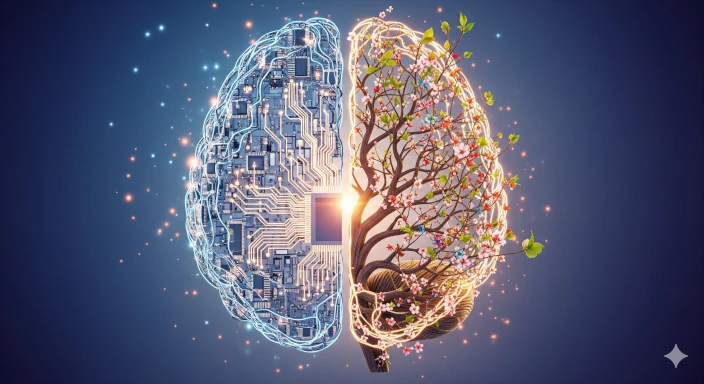How to Humanize AI-Generated Marketing Content
10 min read

The age of frictionless content creation is upon us, but are you sacrificing authenticity for efficiency? We’ve all seen the boilerplate text—grammatically flawless yet devoid of personality—that artificial intelligence often produces. This soulless content, while scalable, risks alienating your audience and undermining the very trust you’ve worked so hard to build. This is why the conversation must move beyond simply generating text to truly understanding how to humanize ai-generated marketing content.
our brand’s unique narrative and relational depth are not negotiable assets. Achieving genuine rapport is a herculean task if your copy sounds like it was written by a disembodied entity. It’s about ensuring your AI content for SEO doesn’t come at the expense of your AI content for brand voice. The central paradox of modern marketing is a simple one: how do you leverage these powerful automated systems without losing the human touch that truly converts?
Imagine a world where your content is both abundant and deeply personal. A world where you have the tools to imbue every piece of copy with a sense of purpose and connection. Leveraging sophisticated AI content humanizer tools and an AI-to-human text converter is no longer a luxury; it is a strategic imperative for any brand seeking to transcend the algorithmic noise. This is not about choosing a side between human and machine.
It is about a synergistic process. You can learn how a comprehensive human-in-the-loop workflow can transform your content. This workflow can help you improve your content, cementing your authority and forging an unbreakable bond with your audience.
The Need for Humanization
A. The Drive to Use Algorithms vs. Human Connection
In today’s digital world, the need to make a lot of content often conflicts with the basic human need for real connection. While AI offers a huge potential for creating content, its writing often lacks the deep understanding and personal feel that draws people in. This is the main problem for modern marketing: trying to get high volume from algorithms while also building a real connection with people. Therefore, the goal is not just to create content, but to give it a soul.
B. The Problem of Scaling: The Role of AI Content Humanizer Tools
AI promises to create content at a speed and size we have never seen before. However, this ability to scale also creates a problem. As you make more content, the risk of making your brand voice generic and impersonal increases very quickly. A flood of boring content can push away your audience, which can weaken your brand instead of building it up. The real value of AI, consequently, is not in making more content, but in helping human creativity focus on more important tasks like improving the message and thinking about strategy. You should therefore use AI content humanizer tools to keep your content real.
C. The Difficult Problem of Voice and Tone
Keeping a brand voice consistent and appealing is a very difficult job, even for a human team. When AI is part of the process, this problem becomes even bigger. For example, without clear and detailed guidance, AI-made content can sound very formal and corporate with no personality. The writing might have perfect grammar, yet it can sound like it was written by something without a body. Successfully using AI depends on our ability to train the models not just on data, but on the small, special qualities that make a brand’s character unique.
D. Why a Human-Centered Approach to Content is a Smart Idea
In a world that is becoming more automated, being real is the new most valuable thing. Brands that fail to focus on a human-centered approach to content risk looking just like their competitors. Their messages will not be unique enough to stand out in a crowded online world. Consequently, a humanized strategy ensures that content connects with people on a feeling level, which creates lasting bonds with customers. Ultimately, this approach builds a history of real communication that is both big and deeply meaningful.

Human-Centered AI
Key Ideas for Human-Centered AI Content
A. Adding Feelings and Details to Your Prompt
The quality of AI writing is directly related to what you put in. To humanize ai-generated marketing content, you must first make your prompt more human. For instance, instead of just telling the AI to “write a blog post about SEO,” a better prompt would be, “write a helpful, reassuring guide for small business owners who feel overwhelmed by SEO, using a friendly and easy-to-read tone.” This changes the focus from a simple technical request to one that is specific about feelings and tone. It is about telling the AI how the content should feel, not just what it should say.
B. Creating a Strong Brand Personality: The Power of AI Content for Brand Voice
Before a single word is created, you must have a clear brand personality. Is your brand the clever expert? The kind mentor? The direct advisor? This personality works as a main guide for all AI-generated content. You can teach the AI to copy a consistent, human-like identity by giving it a detailed description of this persona. Therefore, this is the key to creating excellent AI content for brand voice.
C. The Unique Power of Storytelling
AI is great at bringing information together, but it often struggles with the art of telling a story. Humanizing content needs you to create compelling stories. For example, a good prompt does not just ask for facts; it asks for a story to be told. Tell the AI to “start with a problem people can relate to, add a turning point, and end with a hopeful answer.” This makes the AI structure the content around a human-centered story instead of a simple list of facts.
Simple Ways to Make Content More Human
A. The Art of Editing
The first and most important step in making content human is editing it after it is created. AI cannot, by its nature, have personal experiences. Therefore, the human editor must add personal stories, behind-the-scenes insights, and subjective thoughts. These personal touches act like a signature, confirming that a human hand has shaped the final result.
B. Adding Specifics and Details: The Value of an AI-to-Human Text Converter
A main sign of AI-generated content is its use of general statements. Making content human requires you to move from general to specific. This is where the human touch is not replaceable. Putting in real-world case studies, your own data, and specific examples makes the content real and gives it an air of authority and truth. In effect, you can use an AI-to-human text converter to help with this process.
C. Using a Conversational Style
While AI can be told to use an informal tone, the smart use of everyday sayings and simple sentences is a key sign of human writing. These small language tricks create a natural rhythm and make the content sound like it is being spoken, not just read. For instance, having sentences that are all the same length is a clear sign of robotic writing.
D. Putting in Real Emotion
AI can be told to “be persuasive,” but it is the human editor who can truly add deep feeling and trust. This involves writing information in a way that connects with the reader’s hopes, fears, and values. Furthermore, you must establish the writer’s moral and professional authority.

Write for people not just search engine
E. Writing for People, Not Just Search Engines
Although AI is very good at using keywords, its writing might not always be easy to read. The human editor must make sure the content is broken into small, easy-to-read parts. They should also use subheadings and bullet points and follow accessibility rules, which makes the content easy for any reader to understand. This is a crucial part of your strategy to humanize ai-generated marketing content.
The Human-in-the-Loop Workflow: A Modern Marketing Practice
A. Setting Up a Review System
A structured process is very important. The process should not be a simple “create and publish” model. Instead, it must include a special review system where AI creates the first draft and a human editor acts as the final judge of quality and truth. This is the main idea of a human-in-the-loop workflow.
B. The Final Check: A Sanity Check
The final, important step is a complete editorial check. This is more than just fixing mistakes. It is a check to make sure the content fits your brand values. It also confirms that it feels real and is free of the small oddities that show it was made by a machine. For example, a human eye can easily spot a mistake or an odd phrase that a machine might miss.
C. Checking How People Respond to Your Content
Success should be measured not just by numbers like search rankings and website traffic, but by things that show how people feel. This includes how long people stay on your page, how many times the content is shared, and what people say in comments. These things give you feedback that helps you improve your future efforts to humanize ai-generated marketing content.
D. Using an AI-to-Human Text Converter for Better Work
An AI-to-human text converter can have a very important role in your process. This tool can quickly and easily take AI-made drafts and make the robotic language sound smooth and natural. Consequently, it saves a lot of time for the human editor. The editor can then focus on adding personal stories, unique thoughts, and creative changes that only a human can provide.
The Future of Smart Creativity
A. The Teamwork of AI and Human Skill
The future of marketing content is not about AI replacing humans. Instead, it is about powerful teamwork. AI handles the hard work of writing drafts and organizing ideas, while human skill adds the key layers of feelings, personal experiences, and creative touches. It is a partnership where each side makes the other better. This way of working together is a much more lasting approach.
B. Building a Legacy of Real Digital Communication
In an increasingly automated world, being real is the most valuable thing you can have. By learning the art of humanize ai-written marketing content, we can build a history of digital communication. This communication is not only easy to make in large amounts and efficient, but it is also deeply meaningful, relatable, and truly human. A brand that feels real, therefore, is one that will earn loyalty and trust.
C. Finding the Right Balance Between Automation and Being Real
Long-term success online depends on finding the right balance between automation and being real. Relying too much on AI for speed can lead to all your content looking the same and a loss of your brand’s identity. On the other hand, refusing to use AI can result in a loss of speed and the ability to scale up. The key is to see AI as a helpful assistant rather than a replacement for human creativity.
D. The Key Role of AI Content for SEO in the E-E-A-T World
Google’s focus on E-E-A-T (Experience, Expertise, Authoritativeness, and Trustworthiness) shows how important humanized content is. While AI content for SEO can handle things like finding keywords and some on-page work, it cannot provide real experience or build true authority. This is a human task. Therefore, you must use AI to support your SEO efforts, not to create content that lacks a human’s unique point of view and real-world knowledge.



